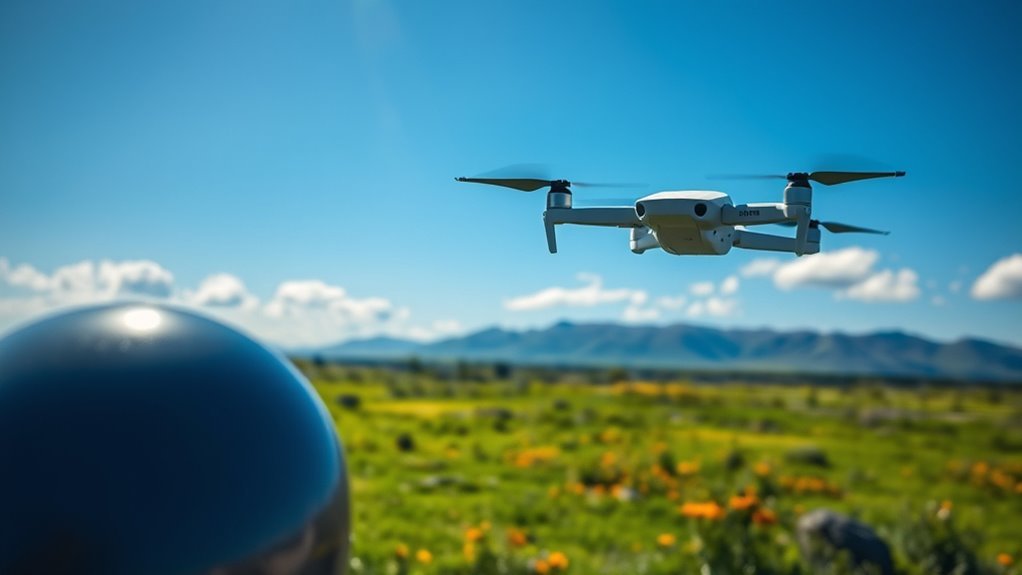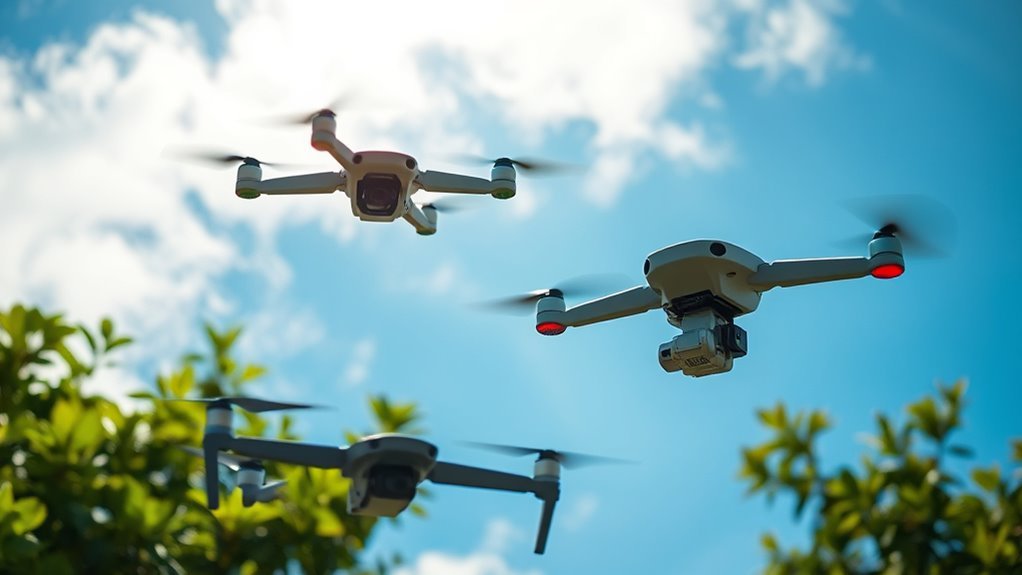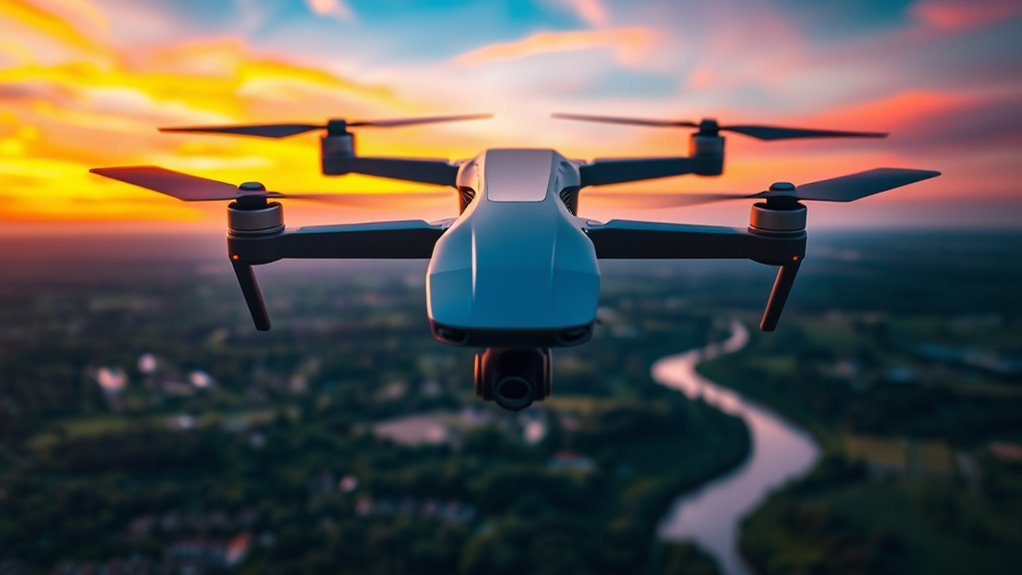Drones typically use 2.4 GHz and 5.8 GHz frequency bands for communication, balancing range, data rate, and interference. You’ll find 2.4 GHz offers better obstacle penetration and longer range, while 5.8 GHz provides higher data throughput but shorter coverage. Consumer drones mostly operate on unlicensed bands, whereas commercial ones may use licensed frequencies for reliability. Regulatory rules also shape frequency use to prevent interference. Understanding these factors can clarify how drone communication performs and evolves.
Overview of Drone Communication Systems

Although drone technology varies widely, their communication systems generally rely on specific radio frequency bands to maintain control and transmit data. You’ll find that these systems use well-defined communication protocols designed for reliability and low latency, essential for real-time maneuvering and data exchange. As someone who values operational freedom, understanding these protocols helps you appreciate how drones achieve secure, interference-resistant links. The protocols often incorporate error correction and encryption to safeguard commands and telemetry. Additionally, they balance bandwidth and power constraints to optimize range and responsiveness. By mastering these communication frameworks, you can better evaluate drone capabilities and regulatory impacts, ensuring your drone operations remain both efficient and compliant without sacrificing autonomy or control.
Common Radio Frequencies Used by Drones

Several key radio frequency bands dominate drone communications, each selected to balance range, interference resistance, and regulatory compliance. You’ll find that 2.4 GHz and 5.8 GHz bands are most common, favored for their effective radio wave propagation and global acceptance under drone frequency regulations. The 2.4 GHz band offers longer range and better obstacle penetration, though it’s more crowded, while 5.8 GHz provides higher data rates with reduced interference but shorter range. Certain drones also use lower frequency bands like 900 MHz in specific regions to maximize range and penetration, albeit with stricter regulatory scrutiny. Knowing these frequencies helps you navigate legal limits and optimize your drone’s communication reliability, ensuring you maintain control while respecting spectrum management principles essential for safe, free flight.
Frequency Bands for Consumer vs. Commercial Drones

When comparing consumer and commercial drones, you’ll notice distinct differences in the frequency bands they utilize, driven by their operational requirements and regulatory constraints. Consumer drones typically operate within unlicensed frequency bands, such as 2.4 GHz and 5.8 GHz, balancing range and interference susceptibility to suit recreational drone applications. In contrast, commercial drones often demand more robust communication channels, sometimes employing licensed frequency bands or dynamic spectrum access to guarantee reliability in complex environments. These choices adhere strictly to frequency regulations designed to minimize interference with other critical systems. Understanding these distinctions helps you appreciate how frequency band selection supports diverse drone applications, granting you the freedom to deploy drones effectively while complying with legal and technical standards that safeguard spectrum integrity.
Why 2.4 GHz and 5.8 GHz Are Popular for Drones
You’ll find that 2.4 GHz and 5.8 GHz frequencies are favored because they balance signal range with stability, essential for reliable drone control. These bands also offer advantages in managing interference and provide sufficient bandwidth for data transmission. Understanding these technical benefits helps explain their widespread adoption in drone communication systems.
Signal Range and Stability
Although other frequencies exist, 2.4 GHz and 5.8 GHz have become the standard for drone communication due to their ideal balance of signal range and stability. When you operate your drone, signal stability is essential to maintain control and guarantee real-time data transmission. The 2.4 GHz band offers superior range optimization, penetrating obstacles better and providing consistent connectivity over longer distances. Meanwhile, 5.8 GHz, with its shorter wavelength, supports higher data rates and reduces latency, enhancing real-time responsiveness though with slightly reduced range. By leveraging these frequencies, you gain a reliable connection that adapts to diverse environments, maximizing your drone’s operational freedom. Ultimately, their combined use empowers you to navigate and control your drone confidently, minimizing signal loss and interruptions during flight.
Interference and Bandwidth Benefits
Because drone operation relies heavily on clear communication, choosing frequencies with minimal interference and sufficient bandwidth is essential. The 2.4 GHz and 5.8 GHz bands excel in interference mitigation by operating within less congested spectrum segments compared to lower frequencies. These bands enable bandwidth optimization, supporting high data rates necessary for real-time video transmission and responsive control. You benefit from reduced signal degradation, which translates to more reliable control and enhanced flight freedom. Additionally, the 5.8 GHz frequency typically experiences less interference from common household devices, further improving signal clarity. By leveraging these frequencies, you optimize your drone’s communication system, balancing range, stability, and data throughput. This strategic choice empowers you with a robust connection, critical for maintaining seamless operation in complex environments.
Impact of Frequency on Drone Range and Signal Quality
When choosing a frequency band for your drone, you need to understand how it directly affects range and signal quality. Higher frequencies often offer faster data rates but suffer from shorter range and increased susceptibility to interference. Conversely, lower frequencies provide better penetration and longer range but may experience more signal congestion.
Frequency Bands Overview
Signal frequency plays a critical role in determining both the range and quality of drone communication. You’ll encounter primary frequency bands like 2.4 GHz and 5.8 GHz, each with distinct characteristics. The 2.4 GHz band offers broader coverage and better penetration through obstacles, benefiting from frequency modulation techniques that enhance signal stability. Conversely, 5.8 GHz provides higher data throughput but with reduced range and sensitivity to interference. Effective signal encryption operates across these bands, safeguarding your control link from unauthorized access. Choosing the right frequency band balances your need for freedom in flight distance and signal clarity. Understanding these bands enables you to optimize your drone’s performance, ensuring secure, reliable communication tailored to your operational environment.
Range Limitations Explained
Understanding the characteristics of 2.4 GHz and 5.8 GHz frequency bands sets the stage for evaluating how these frequencies influence your drone’s operational range and communication reliability. The 2.4 GHz band typically offers greater range due to better obstacle penetration, enhancing drone signal stability over distance. Conversely, 5.8 GHz provides higher data throughput but at a reduced range, impacting range optimization when freedom of movement is essential.
| Frequency Band | Range Potential | Signal Quality at Distance |
|---|---|---|
| 2.4 GHz | Longer | More stable |
| 5.8 GHz | Shorter | Higher data rate, less stable |
Choosing the right frequency balances your need for range versus signal quality, directly affecting how far and reliably your drone can operate.
Signal Interference Effects
Although higher frequencies like 5.8 GHz offer increased data rates, they are more susceptible to interference from physical obstacles and other electronic devices, which can greatly degrade your drone’s communication range and signal quality. Signal degradation occurs as interference sources disrupt the radio waves, weakening the connection. To maintain ideal control and freedom, consider these critical factors:
- Obstruction Penetration: Lower frequencies (e.g., 2.4 GHz) penetrate walls and foliage better, reducing signal degradation.
- Electromagnetic Interference: Wi-Fi, Bluetooth, and other devices operating nearby can cause interference, especially at crowded frequencies.
- Multipath Effects: Reflections from surfaces create signal distortion, impacting clarity and control responsiveness.
Understanding these impacts helps you select frequencies that balance range, data rate, and reliability, ensuring your drone stays connected and free to explore.
Regulatory Standards and Frequency Allocation for Drones
Since drones operate within shared airwaves, regulatory bodies have established specific frequency allocations and standards to minimize interference and secure reliable communication. You must understand that regulatory compliance requires operating primarily in designated bands such as 2.4 GHz and 5.8 GHz, which are internationally recognized for drone use. These standards secure your drone’s radio signals don’t conflict with other vital transmissions. Frequency monitoring plays an essential role, as authorities continuously assess spectrum usage to adapt allocations and enforce limits on transmission power and bandwidth. Adhering to these regulations not only safeguards your freedom to fly but also maintains airspace integrity. By respecting frequency allocation rules, you help create a stable environment where drones can operate efficiently without compromising safety or autonomy.
Interference Challenges and Frequency Management
When operating drones, you’ll often face interference challenges that can degrade signal quality and compromise control responsiveness. Effective interference mitigation relies on precise frequency coordination to maintain reliable communication links. To manage these challenges, you should focus on:
- Dynamic Frequency Selection (DFS): Automatically switches frequencies to avoid congested bands, minimizing interference impact.
- Spectrum Awareness: Continuously monitoring the electromagnetic environment helps detect and adapt to interference sources in real-time.
- Regulatory Compliance: Adhering to allocated frequency bands guarantees you’re not causing or experiencing cross-device interference.
Future Trends in Drone Communication Frequencies
As drone technology advances, you’ll see a shift toward higher frequency bands and more adaptive communication protocols to enhance data throughput and reduce latency. Emerging technologies like millimeter-wave and dynamic spectrum allocation improve spectrum utilization, enabling drones to operate with greater autonomy and freedom. These advances tackle congestion and interference, offering more reliable control links and richer data streaming.
| Trend | Impact on Communication |
|---|---|
| Millimeter-wave (30-300GHz) | Ultra-high bandwidth, short-range control |
| Dynamic Spectrum Access | Real-time frequency optimization, less interference |
| AI-driven Protocols | Adaptive modulation, improved latency control |
Tips for Choosing the Right Frequency for Your Drone
Although selecting the right frequency for your drone involves multiple factors, understanding the trade-offs between range, interference, and data rate is essential. For effective drone frequency selection, you need to identify the ideal frequency range that balances these elements to maximize your operational freedom.
Choosing the right drone frequency means balancing range, interference, and data rate for optimal performance.
- Evaluate Range Needs: Higher frequencies often provide faster data rates but shorter range, while lower frequencies offer extended reach but lower throughput.
- Assess Interference Potential: Urban areas can be congested with signals; choosing frequencies less crowded reduces signal degradation.
- Consider Data Rate Requirements: Missions requiring high-resolution video streaming demand frequencies capable of supporting higher bandwidth.

